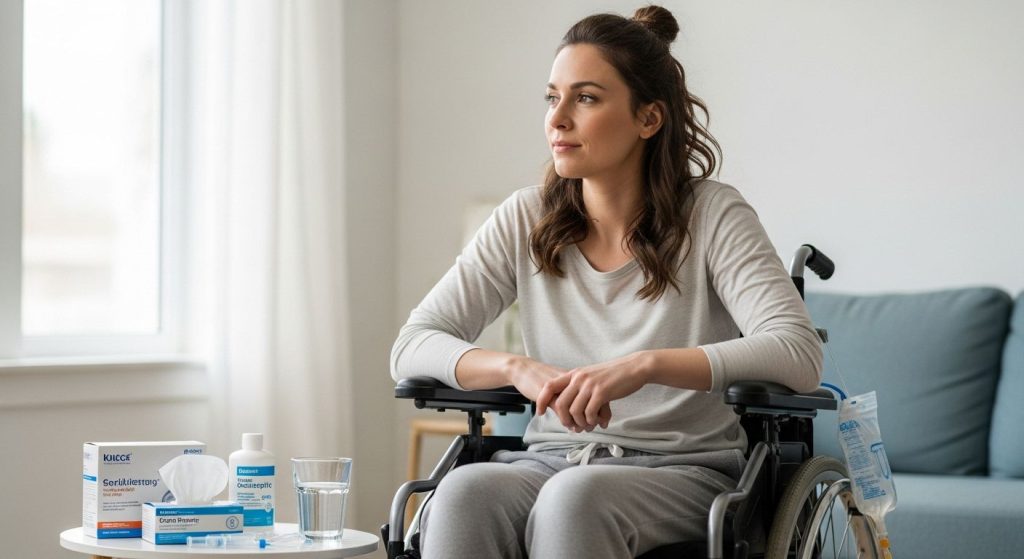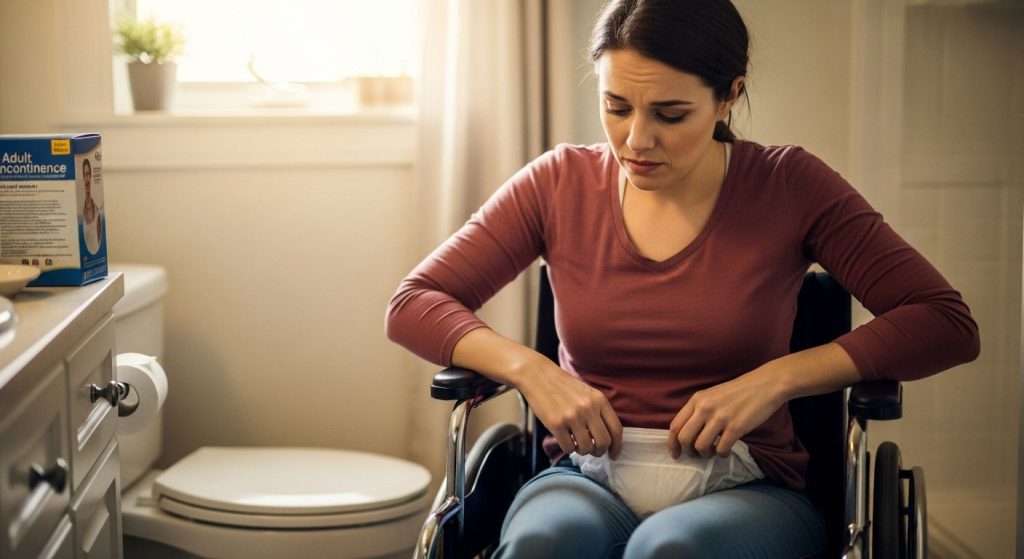Contact us today
SCI & Urinary Health: How Women Can Take Control and Thrive
You know that quiet worry that creeps in before something important; a big work event, a weekend trip, or just a long day ahead? You start to wonder, “Is my bladder going to cooperate today?” Maybe your urine looks a little cloudy, you feel more tired than usual, or something just feels “off.”
If you’re living with a spinal cord injury, you know how tricky it can be to interpret those signs. Urinary tract infections don’t always come with the usual warning symptoms. Sometimes, it’s just fatigue, chills, or an unexpected increase in spasticity that lets you know something’s wrong.
You’re not alone in this. Urinary challenges after SCI are among the most common, and most frustrating, experiences women share with us. Recurring infections, bladder management routines, and pelvic health issues can affect not only your comfort but also your confidence and independence.
This week at HerSpine Solutions, we’re shining a light on what urinary health really means after SCI, and how you can take control and thrive with practical, real-life strategies that go beyond textbook advice. Because you deserve solutions that fit your life, not just your diagnosis.

Bladder Function After SCI: What Changed?
After a spinal cord injury, the nerves at the base of your spinal cord that used to coordinate bladder filling and emptying can become affected and stop communicating properly. This leads to what’s called neurogenic bladder dysfunction, basically, your bladder still works, but it’s lost its instruction manual.
For women, there’s an extra layer to navigate. Because the female urethra is shorter (about 4 cm compared to 20 cm in men), bacteria have a quicker path into the bladder, making urinary tract infections more common. It’s not fair, but it’s the anatomy we’re working with.
And while bladder control is largely physical, emotions play a big role too. Stress, anxiety, and even the fear of accidents can trigger spasms or urgency, creating a cycle that’s hard to break. Learning to understand your body’s unique signals and respond with patience rather than panic is a big part of regaining confidence.
Common Urinary Issues in SCI
When the urinary tract is affected in women with spinal cord injuries, several issues can arise, including:
1. Urinary Incontinence
After a spinal cord injury, bladder control often changes because the messages between your brain and bladder don’t travel the same way they used to. Sometimes the bladder empties on its own without warning. Other times, it holds urine for too long and suddenly releases under pressure. This is called neurogenic incontinence.
For some, it might mean unexpected leaks during transfers, muscle spasms, or when changing positions. For others, it’s the constant uncertainty, “Will I make it through this meeting, this trip, this outing?” That emotional weight is real.
But here’s what’s important: incontinence after SCI isn’t a sign of failure or poor hygiene. It’s a result of nerve damage, not personal weakness. Managing it well often involves a combination of bladder training, catheterisation schedules, timed voiding, and adaptive products like absorbent underwear or waterproof cushions that help you stay comfortable and confident.
And just as importantly, it requires emotional care; giving yourself permission to feel frustrated, to talk about it openly, and to seek out healthcare professionals who respect your lived experience. You deserve dignity, comfort, and the freedom to live your life without shame.
2. Urinary Tract Infections (UTIs)
If you’ve experienced recurring UTIs after a spinal cord injury, you know how frustrating and disruptive they can be, especially when the usual signs aren’t always obvious. Because many women with SCI have reduced or no sensation below the level of injury, symptoms often show up differently. Instead of the familiar burning or itching, you might notice cloudy or foul-smelling urine, increased spasticity, autonomic dysreflexia (sudden blood pressure changes), fever, chills, or simply that “something feels off.”
UTIs happen when bacteria enter and multiply in the bladder, especially if urine isn’t emptied fully or catheters are reused or not properly cleaned. Catheter use, bladder retention, and prolonged sitting can all increase the risk, not just poor hygiene, as many people assume.
For women with SCI, these infections aren’t just medical annoyances. They can drain energy, interrupt routines, and shake your sense of control. So if you’ve felt discouraged by recurring UTIs, know this: you’re not doing anything wrong. Your body is navigating a complex system, and you deserve care, patience, and better solutions, not blame.
💡For guidance on how to manage SCI-related conditions, read our blog post on the secondary conditions that affect women with SCI.

3. Pelvic Floor Dysfunction
After a spinal cord injury, the pelvic floor muscles often lose their connection with the nerves that control them. These muscles are the hidden support system for your bladder, bowels, and sexual organs, and when that communication breaks down, everyday functions can suddenly feel complicated.
For many women, this can mean difficulty emptying the bladder or bowels completely, constipation, pain or discomfort during intimacy, or even changes in sexual sensation. It’s also common to experience infections alongside these challenges because when urine or stool remains in the body for too long, bacteria thrive.
Some days it’s frustrating. But healing happens in layers. Take it one challenge at a time, and celebrate every small progress, whether that’s better bladder emptying, improved comfort, or learning a new routine that makes life a little easier. Working with a pelvic health specialist familiar with SCI can also make a big difference. Remember, you’re not broken, your body just needs new strategies and a little extra care.
4. Kidney Complications
Your kidneys quietly work behind the scenes, filtering waste from your blood and maintaining fluid balance. But when bladder management is inconsistent or infections are left untreated, it can strain the kidneys and lead to complications like stones, inflammation, or long-term damage.
This sounds scary, but here’s the hopeful part, most kidney issues after SCI are preventable with the right bladder care routine. Staying hydrated, keeping up with regular urine tests, and maintaining consistent catheterisation or bladder-emptying schedules are powerful ways to protect your kidneys.
Think of kidney care as a long-term partnership with your body. It’s not about perfection, it’s about consistency: small, daily acts that keep you healthy and thriving.Your kidneys quietly work behind the scenes, filtering waste from your blood and maintaining fluid balance. But when bladder management is inconsistent or infections are left untreated, it can strain the kidneys and lead to complications like stones, inflammation, or long-term damage.
This sounds scary, but here’s the hopeful part, most kidney issues after SCI are preventable with the right bladder care routine. Staying hydrated, keeping up with regular urine tests, and maintaining consistent catheterisation or bladder-emptying schedules are powerful ways to protect your kidneys.
Think of kidney care as a long-term partnership with your body. It’s not about perfection, it’s about consistency: small, daily acts that keep you healthy and thriving.
How to Manage Bladder Control After SCI
Managing urinary health after SCI doesn’t mean you have to suffer through every condition. Instead, it’s about finding practical strategies to reduce infections, protect your kidneys, and support your body through its healing process. While these steps may not completely fix the changes caused by SCI, they can make a big difference in your comfort, confidence, and quality of life.
1. Stay Hydrated
One of the most important ways to stay in control of your urinary health is to remain hydrated. Even when you don’t feel like it, keep a bottle of water with you at all times. Women with SCI are encouraged to drink around 2-3 liters (8-12 glasses) of water every day. You may think, “That’s A LOT of water,” and you’re right! But, there are great benefits to constantly flushing out your kidneys and bladder.

Hydration does more than just prevent UTIs; it supports kidney function, helps manage bowel issues like constipation, and keeps your entire system balanced. Try to limit drinks that contain caffeine or alcohol, as these can dehydrate you or irritate the bladder.
It may seem easier to reduce your water intake to avoid frequent catheterization, but this can backfire, leaving you dehydrated and more prone to infections. If you’re finding it hard to balance your fluid intake with catheter use, talk to your urologist or spinal cord injury specialist. They can help you find a safe, manageable rhythm that works for your body and lifestyle.
💡Learn more in this article about fluid management for people living with SCI.
2. Prevent Infections Proactively
One of the most common urinary health challenges after SCI is urinary tract infection (UTI). The good news is that you can take proactive steps to lower your risk. Here are some simple habits that help:
a). Stay clean: Take regular baths or gentle showers, using mild, fragrance-free soap.
b). Avoid frequent use of public restrooms where hygiene may be uncertain.
c). Wipe from front to back after bowel movements to prevent bacteria from spreading to the urethra.
d). Choose breathable fabrics, especially cotton underwear, to keep the area dry.
e). Listen to your body: Even if you have reduced sensation, watch for signs like cloudy urine, unusual odour, fever, or discharge. These can all be infection warnings.
f). Support your body naturally: Some women find cranberry supplements, probiotics, or vitamin C helpful in maintaining a healthy urinary balance. Always discuss these with your healthcare provider first.
3. Master Catheter Care
For many women with SCI, catheterization becomes part of daily life, not as a limitation, but as a way to regain control and comfort. Choosing the right catheter type and size can make a big difference. Most women use 10–14 French sizes, but your ideal size depends on your body and your doctor’s recommendation. There are two main options:
Intermittent catheterization: You insert and remove a catheter at intervals to empty the bladder, giving you more flexibility and reducing infection risks when done properly.
Indwelling catheterization (Foley): A catheter stays in place and drains urine continuously into a collection bag. This can be helpful for those with limited hand function or frequent bladder spasms.
Whichever method you use, hygiene and consistency are key:
a). Single-use catheters are best not reused, as reusing them increases infection risk, even when washed. However, some women use reusables under medical guidance and strict cleaning routines.
b). Always wash your hands before and after catheterization.
c). Inspect your urine regularly: If it becomes cloudy, bloody, or has an unusual smell, reach out to your healthcare provider immediately.
d). Hydration helps: Aim for 8–12 glasses (2–3 litres) of water daily, unless your doctor advises otherwise.
Remember, catheter care is self-care, a way to support your independence and overall wellbeing.
4. Build Your Support Team
You don’t have to do it alone. Managing urinary health after SCI becomes much easier when you allow others to walk the journey with you.
a). Find urologists who truly understand the unique challenges of urinary health after SCI.
b). Work with pelvic floor therapists to get personalised recommendations that help your body function better and feel stronger.
c). Join support groups and open up to family or friends who can offer practical help and emotional comfort when you need it most.
d). Ask questions, all of them! There’s no such thing as a silly question when it comes to your body and wellbeing.
💡 Navigating healthcare providers? Check out our newsletter on choosing the right physiotherapist for SCI recovery. It’s full of practical tips for finding specialists who truly understand your needs.
Live Fully, Not Fearfully
Bladder management is just one part of your SCI journey, it’s important, but it doesn’t define who you are. Some days might feel harder than others, and that’s completely okay.
Celebrate the small victories: a day without infection symptoms, successfully managing an outing, or simply feeling more confident in your routine. These wins matter, even when they might seem mundane to others. Speak up about any issues you face, and stay active with physical activities you enjoy. Your urinary health challenges are part of your story, but they don’t define your possibilities or limit what you can achieve.
And remember, you’re not alone! Join other women at our HerSpine Virtual Ladies Lounge, a bimonthly online gathering where women share real-life tips that actually work. Come as you are, share your story, and pick up ideas that make daily life easier. Join our next meeting here, because managing urinary health isn’t just about catheters and check-ups, it’s about reclaiming your confidence, your comfort, and your freedom to live fully.

Conclusion
Managing urinary health after SCI takes vigilance, medical guidance, and emotional support. Learn what’s happening in your body, speak up when something doesn’t feel right, and keep advocating for a healthier, more fulfilling life.
Thriving with SCI isn’t about achieving perfect bladder control. It’s about having the knowledge, tools, and community to live fully on your own terms. Remember, you’re navigating a truly complex process and doing it with courage and grace, even on the hard days.
💡 Want more insights like this? Subscribe to our LinkedIn newsletter for weekly inspiration, practical tips, and real stories about living well with SCI.
FAQs
a). Can my bladder function improve after SCI?
Bladder function after SCI depends on the level and completeness of your injury. While the spinal cord itself doesn’t regenerate, your body can adapt, and that’s where bladder management strategies come in. With the right medical support, many women find routines that make daily life easier and more comfortable. Work closely with a urologist familiar with SCI, and remember that improvement doesn’t always mean “cure”, sometimes, it simply means fewer leaks, fewer infections, and more confidence in your day-to-day life.
b). Can I still have a social life while managing urinary issues?
Absolutely. Having bladder challenges doesn’t mean your social life ends; it just means learning how to plan differently. Carry your supplies, know where accessible restrooms are, and use protective products that make you feel secure. If you use a catheter, map out private, accessible spaces in advance. You deserve connection, fun, and friendship, and many women with SCI find that confidence grows with preparation. And remember, it’s okay to laugh, to live, and to show up as you are, not everything has to revolve around bladder management.
c). How do I know if my bladder is working properly?
Listen to your body and pay attention to subtle changes. Warning signs like recurring UTIs, cloudy urine, difficulty emptying, or new leaks can all suggest that something needs attention. Keeping a bladder diary, tracking how much you drink, how often you catheterise or void, and any changes in sensation, can be incredibly helpful. Share this with your urologist or SCI nurse; it gives them a clearer picture than tests alone. Remember: your experience and intuition matter just as much as the clinical data.

 0330 043 4887
0330 043 4887